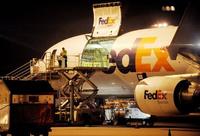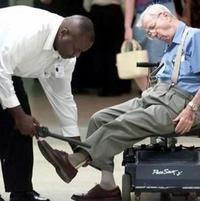-
Real-time detection of PETN explosive with PTR-MS
PETN is an extremely powerful explosive, belonging to the nitroglycerine family, but is very stable; it is therefore a preferred explosive used by terrorists; a major problem for security personnel is that PETN is difficult to detect; academic, commercial organizations collaborate to develop PTR-MS technology for the detection of explosives — not only PETN, but also TNT, RDX, Semtex, and HMX
-
-
Cargo bomb aftermath: end for in-flight cellular, Wi-Fi connection

The aviation industry is gearing up to provide broadband in-flight entertainment systems that feature both cell phone and Wi-Fi connections for passengers; in-flight communications is a fast-growing market at the moment — but the discovery last week of the cargo bomb plot now casts doubt on the wisdom of in-flight communications; we now know that the cell phones in the printer bombs were not intended to be triggered remotely, and were intended simply as timers, as in the 2004 Madrid train bombings; future devices, though, could take advantage of wireless communication, meaning that on-board bombs could be triggered remotely, from the ground, by a cell phone
-
-
Cyber attack could paralyze air traffic
This summer we saw the release of the world’s first cyber superweapon, which was said to be targeting Iran’s nuclear facilities as well as infrastructure systems in China; the Stuxnet worm could break into computers that control machinery at the heart of industry, allowing an attacker to assume control of critical systems like pumps, motors, alarms and valves; a similar cyber weapon could allow an attacker to take down air-control systems
-
-
Closing gaping cargo security holes prohibitively expensive
The technology exists to safeguard the world’s air-transport system against threats such as the Yemen-based mail bombs, but the cost may be too high to be practical; swabbing packages individually for explosives is considered the most effective way to scan, but this is not a practical option for the millions of packages that crisscross the globe every day; the cost of these machines would likely be in the billions of dollars, and would be economically impossible for some countries
-
-
Only 20 percent of U.S.-bound cargo screened for bombs
About 20 percent of the nine billion pounds of air cargo that comes from overseas each year is physically checked for bombs; at some overseas airports, cargo is checked for bombs before being put on planes, but that screening could be below U.S. security standards, according to the U.S. Government Accountability Office (GAO); the TSA may start forcing airlines to inspect suspicious cargo before a plane takes off from overseas. the agency is studying whether the tracking system can target certain U.S.-bound air cargo for screening prior to departure
-
-
New nano explosive sniffer would have detected cargo bombs
Israeli scientists developed a nanotechnology-based sensor capable of detecting numerous types of explosives and can also be adapted to detect chemical and biological toxins; the researchers say that the sensor is particularly effective at detecting explosives like those used in the parcel bombs sent from Yemen to the United States
-
-
Yemen may impose 100% air freight screening

In the wake of explosives being shipped from Yemen to the U.S. on 29 October, Yemeni authorities are stepping up efforts to boost security; one measure likely to be adopted is 100 percent air freight screening; government officials warn that tighter screening alone is not the answer; Qatar Airways confirmed it moved one of the packages from Yemen, via its Doha hub, to Dubai, where the explosive device was discovered; the airline CEO, Akbar Al Baker, stresses, however, that it was not the airline’s responsibility, but that of authorities. to conduct the searches
-
-
Plotters had no control over where cargo bombs would go off
The plotters behind last week’s unsuccessful mail bombings could not have known exactly where their Chicago-bound packages were when they were set to explode; the communication cards had been removed from the cell phones attached to the bombs, meaning the phones could not receive calls, making it likely the terrorists intended the alarm or timer functions to detonate the bombs; each bomb was attached to a syringe containing lead azide, a chemical initiator that would have detonated PETN explosives packed into each computer printer toner cartridge; both PETN and a syringe were used in the failed Christmas Day bombing of a Detroit-bound airliner linked to an al Qaida branch in Yemen
-
-
U.K. airlines support Broughton's criticism of U.S. security requirements

Martin Broughton, the chairman of British Airways, said some parts of the U.S.-inspired aviation security program are “completely redundant” and Britain should stop “kowtowing” to the United States every time the United States wants something done; Broughton said people should not be forced to take off their shoes or have laptops checked separately when checking in for flights; nor was there any need to pander to the Americans especially when it involves checks the U.S. government does not impose on U.S. domestic routes
-
-
Biometric-driven airport gates gain ground
Biometrics-driven border controls in the United Kingdom are now well advanced, with a trial at London Stansted so successful, that the technology is now being rolled out at Heathrow Airport; still, biometric-driven airport gate technology is still in its infancy, with only around 1,000 gates in active use worldwide
-
-
Australia's airports easy prey for terrorists
New report says Australia’s airports Aussie airports are “wide open” to terror attacks with lax security vetting of staff, poor perimeter protection, and no strategy to counter car bombs; security protocols and standards at Australia’s airports developed to keep the 2000 Olympic Games safe ceased to exist six months after the closing ceremony
-
-
Six years later, U.S. pilot's licenses still not secure
In 2004 Congress told the Federal Aviation Administration (FAA) to come up with a pilot’s license that included the pilot’s photo and could contain biometric information like fingerprints or iris scans; critics charge that today, the only pilots pictured on FAA licenses are flight pioneers Wilbur and Orville Wright, and the licenses lack biometric data
-
-
End to limits on carrying liquids on board in sight
New bottled liquid scanners unveiled; researchers at the Los Alamos National Laboratory developed a magnetic resonance device to read liquids’ molecular makeup, even when the substances are in metal containers; the device is so sensitive it can tell the difference between red and white wine, and between different types of soda; satisfactory test result may spell the end of limitations on carrying liquids on board
-
-
TSA agent pulls a woman's blouse down, exposing breasts
An Amarillo woman is suing the U.S. federal government for intentional infliction of emotional distress; the woman says she was frisked by a male TSA agent, who then pulled her blouse completely down, exposing her breasts to everyone in the area
-
-
Final phase of TSA's Secure Flight program taking effect
As of 1 November, all domestic airlines will collect passengers’ names, dates of birth, and gender of passengers at the time of booking a flight; international carriers will do the same by the end of the year; passengers who do not enter all information at least seventy-two hours prior to departure will not be able to print out boarding passes
-
More headlines
The long view
New Technology is Keeping the Skies Safe
DHS S&T Baggage, Cargo, and People Screening (BCP) Program develops state-of-the-art screening solutions to help secure airspace, communities, and borders
